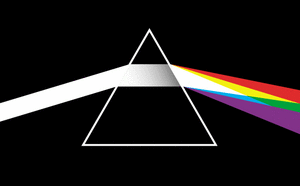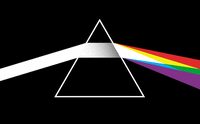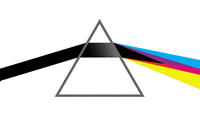Theory of Colours facts for kids

Light spectrum, from Theory of Colours – Goethe observed that colour arises at light-dark edges, and the spectrum occurs where these coloured edges overlap.
|
|
| Author | Johann Wolfgang von Goethe |
|---|---|
| Original title | Zur Farbenlehre |
| Translator | Charles Eastlake m0422/is 2 82/ai 64573524/pg 6 |
| Language | German |
| Publisher | John Murray |
|
Publication date
|
1810 |
|
Published in English
|
1840 |
Theory of Colours (which means Zur Farbenlehre in German) is a famous book written by Johann Wolfgang von Goethe. It was published in 1810. This book describes how we see colors, including things like colored shadows, how light bends (called refraction), and how lenses can sometimes show blurry colors (called chromatic aberration).
Goethe's ideas about color were very important for artists. Groups like the Pre-Raphaelites used his ideas in their art. The famous painter Turner studied the book carefully. He even used its ideas in the names of some of his paintings. Another artist, Wassily Kandinsky, thought Goethe's theory was "one of the most important works" ever written about color.
Even though scientists called physicists didn't always agree with Goethe, many important thinkers studied his work. These included Arthur Schopenhauer, Kurt Gödel, Werner Heisenberg, Ludwig Wittgenstein, and Hermann von Helmholtz. Some, like Mitchell Feigenbaum, even came to believe that "Goethe had been right about colour!"
In his book, Goethe explored how we see colors in different situations. He thought that Isaac Newton's ideas about color were just special examples. Goethe was more interested in how we experience colors, not just measuring them. Today, science understands the difference between the optical spectrum (what Newton studied) and how humans actually see colors (what Goethe explored).
Contents
What Was Goethe's Color Theory?
Goethe believed that to truly understand something, you need to see that "all facts are really theories." He said, "The blue of the sky reveals to us the basic law of color. Search nothing beyond the phenomena, they themselves are the theory." This means he thought we should look closely at what we see, because the answers are right there.
Goethe's book, Data for a Theory of Color, was full of important observations. However, he didn't try to explain what color truly is. Instead, he focused on how colors appear. He saw colors as something that happens, without trying to connect them to other types of colors. As Arthur Schopenhauer wrote, Goethe's book was a great collection of facts, but it didn't go further to explain the deep nature of color.
How Do Turbid Materials Affect Color?
Goethe started his color studies by doing simple experiments. He looked at how light and dark appeared when seen through "turbid media." This is a fancy way of saying cloudy or hazy materials.
He noticed that light looked yellowish when seen through a slightly cloudy material. But if he looked at darkness through a cloudy material that was lit up, it appeared blue.
Goethe wrote:
- "The brightest light, like the sun... is mostly colorless. But if you look at this light through a slightly cloudy material, it looks yellow. If the material gets thicker, or if there's more of it, the light will slowly turn yellow-red, and then a deep ruby color."
- "On the other hand, if you look at darkness through a see-through material that is lit up, a blue color appears. This blue gets lighter as the material gets thicker. But it gets darker and deeper if the material is more see-through. If the material is just a little bit cloudy, but still clear, this deep blue looks like the most beautiful violet."
These observations led him to do many more experiments. He wanted to see how making things darker or lighter changed how we see colors in different situations.
How Do Darkness and Light Create Color?
Goethe believed that light was "the simplest, most whole, most pure thing we know." And opposite to light was darkness. Unlike other scientists of his time, Goethe didn't think darkness was just the absence of light. He saw light and darkness as two opposing forces that interact with each other.
Based on his experiments, Goethe thought that colors appear because of the active play between darkness and light. Imagine light and darkness like the north and south poles of a magnet. Darkness can make light weaker, and light can limit the power of darkness. When they interact in this way, color is created.
Goethe explained it simply:
- Yellow is light that has been softened by darkness.
- Blue is darkness that has been weakened by light.
What Happens at Color Boundaries?
When you look at things through a prism, how a light-dark edge is placed matters a lot. If you have white above a dark area, the light seems to stretch a blue-violet edge into the dark. But if you have dark above a light area, a red-yellow edge stretches into the light.
Goethe found this difference very interesting. He felt that colors appearing at these light-dark edges were key to how the full spectrum of colors is made. He thought the spectrum was a combination of these simpler color effects.
How Do Light and Dark Spectra Form?
Since colors appear when light and dark are next to each other, you can make a spectrum in two ways. You can use a beam of light in a dark room. Or, you can use a dark beam (like a shadow) in a light room.
Goethe wrote down the order of colors he saw at different distances from a prism for both situations. In both cases, he found that the yellow and blue edges stayed closest to the light side. The red and violet edges stayed closest to the dark side. At a certain distance, these edges would overlap. When they overlapped in a light spectrum, green appeared. When they overlapped in a dark spectrum, magenta appeared.
In a light spectrum, as light comes out of the prism, you see a beam of light surrounded by darkness. You'll find yellow-red colors along the top edge and blue-violet colors along the bottom edge. The green in the middle of the spectrum only appears where the blue-violet edges meet the yellow-red edges.
In a dark spectrum (a shadow surrounded by light), you'll see violet-blue along the top edge and red-yellow along the bottom edge. Where these edges overlap, you'll find magenta.
Goethe vs. Newton: Different Views on Color
Isaac Newton and Goethe had very different ways of looking at color. Newton used math to understand light, while Goethe focused on how we experience color. This led to many misunderstandings between their ideas.
Newton believed that white light is made up of all the different colors mixed together. Goethe, however, thought that colors appear when light and dark interact. Because of this, they had different answers to a big question: Is the optical spectrum (the rainbow of colors) a basic thing, or is it made up of simpler parts?
Newton thought that all colors already exist in white light. He believed the prism just spreads them out based on how much they bend. Goethe wanted to show that the prism itself, as a cloudy material, was an important part of how colors appear.
Newton made his beam of light very narrow to study the colors. But Goethe noticed that with a wider opening, there was no full spectrum. He only saw reddish-yellow edges and blue-cyan edges with white in between. The full spectrum only appeared where these edges came close enough to overlap. For Goethe, the spectrum could be explained by the simpler idea of colors appearing from the interaction of light and dark edges. Most modern physicists don't agree with Goethe's idea that darkness is a real thing, which is why they often reject his theory.
Newton explained why white light sometimes has colored edges. He said that because light rays bend differently, they mix together to create pure white in the middle. But at the edges, they don't mix completely, so you see more red or blue.
How Newton and Goethe Saw Color Differently
Here's a quick look at how their ideas compared:
| How Light Behaves | Newton's View (1704) | Goethe's View (1810) |
|---|---|---|
| What is white light? | White light is made of different colored parts. | Light is the simplest, most whole, and pure thing. |
| What is darkness? | Darkness is just the absence of light. | Darkness is the opposite of light and works with it. |
| How does the spectrum form? | Colors are spread out from light based on how much they bend (a basic thing). | Colored edges that appear at light-dark borders overlap to form a spectrum (a combined thing). |
| What does the prism do? | The prism doesn't create color; it just shows what's already there. | The prism, as a cloudy material, helps colors appear. |
| Role of bending light (refraction) | Light breaks down into colors through bending, turning, and reflecting. | Bending, turning, and reflecting light can happen without colors appearing. |
| How many pure colors? | White light breaks down into seven pure colors. | There are only two pure colors – blue and yellow; others are shades of these. |
| Can colors combine? | Just as white light can be broken down, it can be put back together. | Colors combine to make shades of gray. |
| Is light a particle or wave? | Particle | Neither, because these are ideas, not things we see with our senses. |
| Color Wheel | Uneven, 7 colors | Even, 6 colors |
Images for kids
-
J. M. W. Turner's The Fighting Temeraire, 1839
See also
 In Spanish: Teoría de los colores para niños
In Spanish: Teoría de los colores para niños










